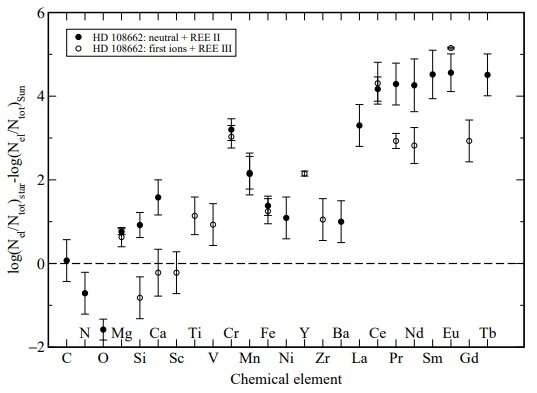Element abundances in the atmosphere of HD 108662. Credit: Romanovskaya et al., 2020.
Astronomers have carried out a spectroscopic analysis of the atmosphere of a magnetic chemically peculiar star designated HD 108662. The study, described in a paper published June 29 on the arXiv preprint server, resulted in determining fundamental parameters of this star.
Chemically peculiar (CP) stars are those with unusual metal abundances, thus exhibiting strong or weak spectral lines for certain elements. Some CP stars are observed to have stronger magnetic fields than classical A- or B-type stars, varying from few tens of Gauss to tens of kiloGauss, and are hence known as magnetic chemically peculiar (mCP) stars (Ap and Bp stars). This class of objects is perceived by astronomers as a natural atomic and magnetic laboratory to study stellar formation and evolution.
However, the unusual chemical composition of atmospheres of CP stars makes the determination of their fundamental parameters difficult. Knowing the properties of these objects is important to unveil their evolutionary states, for instance, and could be essential for testing theoretical models of pulsations in magnetic stars.
HD 108662 (also known as 17 Com), is a magnetic chemically peculiar star of A0p spectral class. Recently, a team of astronomers led by Anna Romanovskaya of the Institute of Astronomy of the Russian Academy of Sciences (RAS) in Moscow, Russia, has employed an iterative method to shed more light on the parameters of this star.
"It consists of subsequent refinement of model structure and spectroscopically derived abundances until the agreement between predicted and observed spectra is achieved. This approach was successfully used to study the atmospheres of many Ap stars," the researchers explained.
For their study, Romanovskaya's team used the data mainly from the Echelle SpectroPolarimetric Device for the Observation of Stars (ESPaDOnS) at the Canada-France-Hawaii Telescope (CFHT) in Hawaii. The method used by them required four iterations to obtain final best-fit parameters for HD 108662.
"We carried out a detailed analysis of the atmosphere of the chemically peculiar star HD 108662 using high-resolution spectroscopic and low-resolution spectroscopic observations calibrated to absolute units," the authors of the paper wrote.
The researchers found that the mean element abundances in the atmosphere of HD 108662 are typical for Ap stars. The studied object showcases excesses up to an order of magnitude of abundances of iron peak elements and very significant excesses of rare-earth elements, compared to the atmosphere of the sun. Moreover, the results show a significant helium deficiency and that chromium is distributed homogeneously in the star's atmosphere.
The study found that HD 108662 has a radius of about 2.09 solar radii and effective temperature of some 10,212 K. The rotational velocity of the star was estimated to be 20.4 km/s and the strength of its surface magnetic field was measured to be approximately 3,300 Gauss.
More information: Romanovskaya et al., Fundamental parameters of Ap-star HD 108662, arXiv:2006.15950 [astro-ph.SR]. arxiv.org/abs/2006.15950
© 2020 Science X Network
























